Tag: vision
October 4, 2012

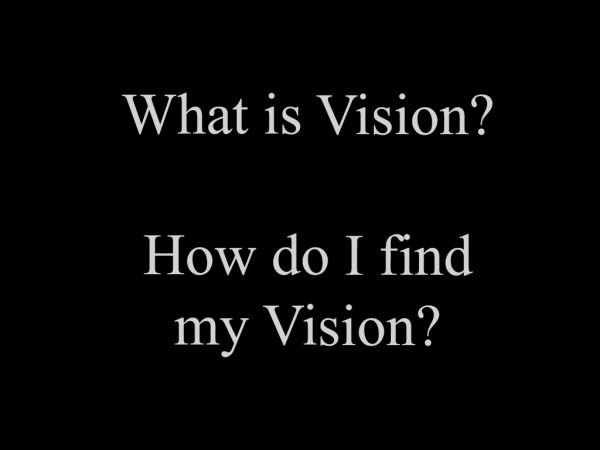
Recently a friend told me of her frustrations as she sought to find her Vision and this brought back memories of my own journey. For years I was confused as to what Vision was and frustrated because I didn’t know how to find mine.
I had absolutely no idea how to find my Vision. I was told that I had to keep working at it, but how? It was frustrating because it was such a nebulous concept and I had no idea how to proceed.
And the truth was that I wasn’t sure that I was capable of having Vision. I was raised in a home where the arts were not emphasized and I never developed creative skills; instead I was logical, methodical and gravitated towards mechanical things. I wondered if some people were just naturally creative and others were not, and feared that I was in the “not” category.
The good news is that not only did I find my Vision but I am absolutely convinced that everyone has one. It may be buried deep under a lot of “stuff” and it may be atrophied from lack of use, but it is there and you can find it.
What is Vision? It is the sum total of my life experiences that makes me see the world in a particular way. Because my experiences are different than yours, my Vision will be different than yours. And since my Vision is based on my experiences, it will change with time.
Vision is what makes me see an image that others may not see, or see it differently. Have you viewed a great image that was created where you had photographed before? I used to wonder why someone else could see that image and I could not, I believe it’s because we have different Visions. The good news is that it works both ways and sometimes you’ll see an image where others do not. The important point is that you should pursue your Vision and not try to see what others see.
Because Vision is simply your experiences and how you see life, I am convinced that everyone has one. It just needs to be discovered. Sometimes that is hard because it can be buried beneath a lot of “stuff” such as self doubt and a lack of creative experience, as was in my case. But I found mine and am absolutely convinced that each person is capable of finding theirs too.
So how did I go about finding my own vision? I had this idea that to follow my Vision was synonymous with following my heart and so I took all of my images and divided them into two piles; ones that I REALLY loved and everything else. I purposely ignored “good” images or ones that others liked and ones that sold the best because I didn’t want to consider what others thought, I only wanted to consider what I thought.
Then I started studying those images to understand what they had in common. I noticed that when I was doing what I loved and pleasing myself, my images had a particular look and mood. I also noticed that what I was photographing and how I was photographing was changing; I was moving away from my landscape roots and creating a different kind of work.
Once I found my Vision, there was still a challenge, and that was to religiously follow it. I was so used to copying others, pleasing others and following trends that I had to train myself to only pursue images that followed my Vision. When you copy others, the best you can ever hope to achieve is being a great imitator. When you seek to please others, you end up not pleasing yourself. When you follow trends, you are like the blowing grasses which are buffeted by every wind. Following your Vision is the only way to achieve satisfaction.
Over the course of two years (it was a slow and painful process) I found my Vision. It was not a “Eureka!” moment, but rather it crept up on me slowly until one day I just realized that I had one. I cannot put my Vision into words, but now I understand it and what was once so mysterious now seems so simple.
Finding my Vision gave me a tremendous feeling of freedom and confidence. I no longer felt constrained or bound by the opinions of others, I was free to create what I wanted and how I wanted, regardless of who liked it. The most important thing was that I was happy with my work. Finding your vision does not guarantee critical or financial success, but it will bring about personal satisfaction. Ironically, as I stopped caring what others thought and created for myself, my work became more popular with others.
Vision is more important than your equipment, your location or your processing techniques. Vision is the most important ingredient in a great image and I am absolutely convinced that everyone can find theirs.
Cole
July 28, 2012
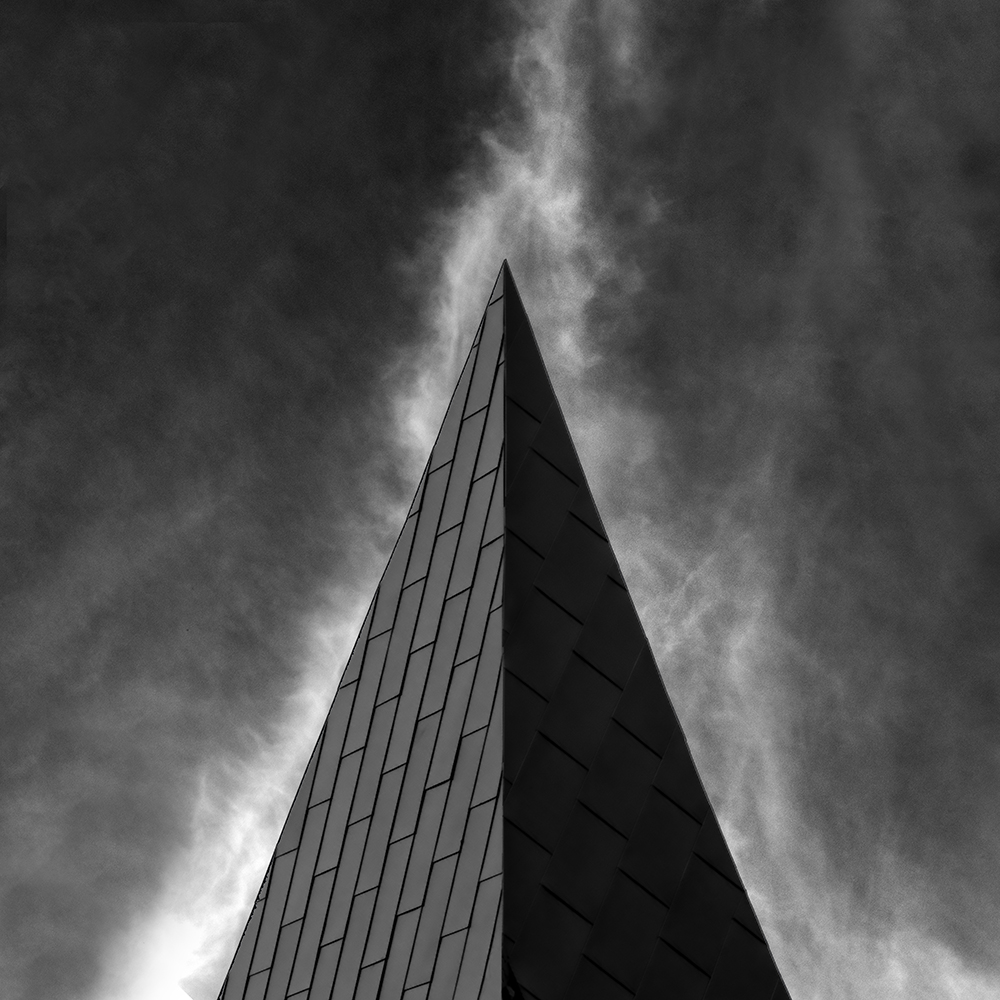
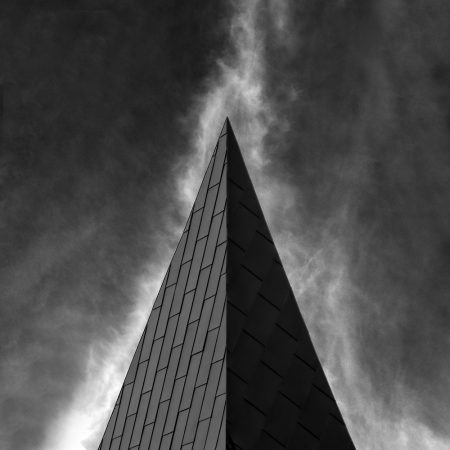
I often tell people not to follow other people’s advice. However, if you follow this advice then you wouldn’t follow my advice…which would mean that you actually should follow my advice. What a conundrum!
Everyone loves to give advice; we all know how others should live their lives even better than we know how to live our own, and it’s no different with our art. Everyone wants to tell us how we should process our images and how we should best achieve success. The advice givers are good people, who are well intentioned and who have had some wonderful life experiences, so why shouldn’t you follow their advice?
Because their vision is different from your vision and their definition of success may be different than yours. Can you imagine what might happen if I was inclined to give you lots of advice and you were inclined to follow it? One day you might wake up to the realization that your images bore a striking resemblance to mine and that you had met every one of the goals that I had set for myself! It’s not that my advice is bad, it simply may not be right for you.
Over the years I’ve come to learn that the only opinion that really matters is your own. Let me illustrate with two examples of some well-intentioned advice that I’ve received:


Never Center the Image!
A few years back my friend and mentor saw my latest image entitled The Angel Gabriel and almost yelled “Never center the image!” I was frequently presenting her with centered images (see above) and she constantly told me that I was breaking one of the rules of photography. I respected her position and experience but the advice just didn’t feel right to me. However since she was the teacher and I the student, I reluctantly re-cropped the image as she had advised… and I just hated it! It literally made me ill to look at it and at that moment I realized that this was my image and my vision and no one could tell me how it should look. It wasn’t that her experience wasn’t good, but it came from her vision and it wasn’t right for me.
It is critically important that you find your own vision and once you do, you’ll find less and less of a need to ask others for advice about your work.
Large Prints, Small Editions:
I have a friend who is attempting to earn his living from his photography. He has chosen to offer large prints and very small editions (as low as 12). He believes this will maximize his profits and thinks my open editions and lower prices is a bad idea. He has frequently tried to convince me that I am making a mistake and that I should follow his example.
The problem with his advice is that he and I have different definitions of success and therefore different goals. I am not trying to earn a living from my art, I wouldn’t be happy in the Gallery environment and I couldn’t stand the thought of printing only 12 images and then never any more! This formula would not work for me, even though it may work for him.
It is so important that you define success for yourself. What do you want from your art? What will bring lasting satisfaction? In five years, what would you like to accomplish with your art? Only once you know the answer to these questions, can you set your own course with confidence.
So listen to others and consider their ideas, but do not follow someone’s advice simply because they have more experience than you, create beautiful images or are successful. When it comes to your vision and what you want from your art, nobody is better qualified than you to make those decisions.
There is tremendous confidence and strength that comes from finding your own vision and knowing what you want from your art. Life becomes so much easier, so much simplier and so much quieter.
Cole
April 27, 2012
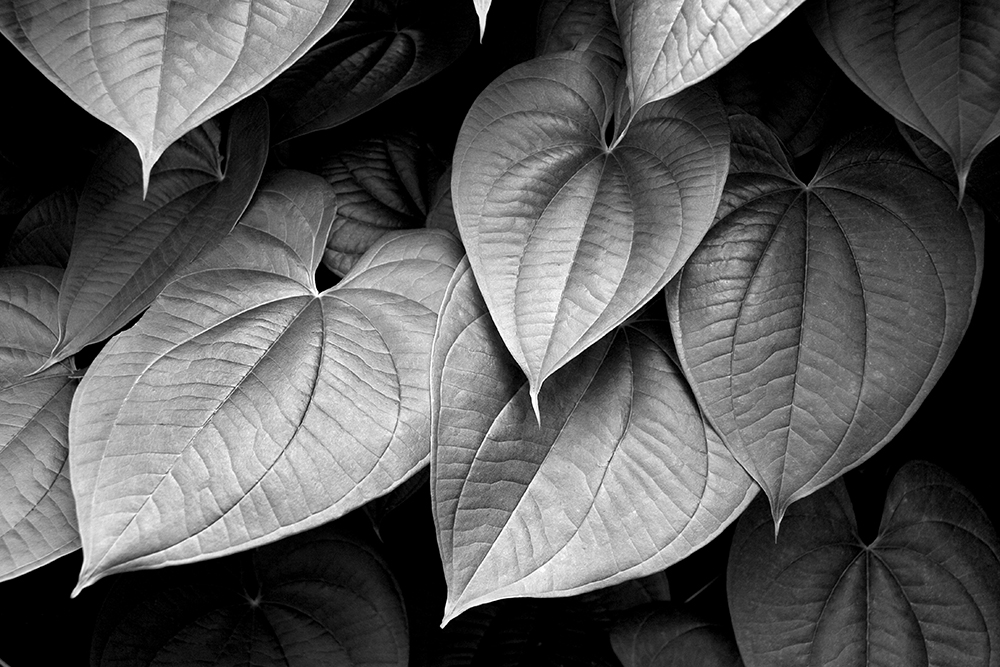

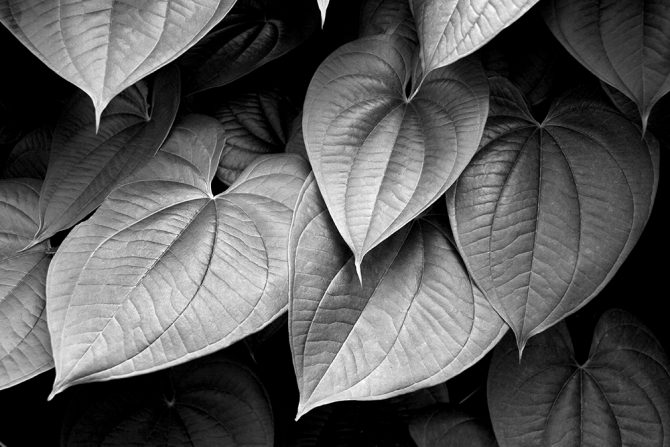
A friend and I were recently talking about how to set the price for our images and this brought up some thoughts I’ve had over the years. Typically people price their work in one of three ways:
1. Cost method, total up your costs and then add a percentage for profit.
2. What others are charging for “similar” work. If others are getting $150 for an 8 X 10 then I should be able to get that too.
3. What the market will bear.” Price your work as high as it will sell for and get as much as you can.
First let me say that if you’re trying to earn your living from your photography, then ignore everything I’m about to say. I made a purposeful decision not to earn a living from my art because I didn’t want to lose my passion for it if I “had” to do it every day. Looking back these many years, I do not regret that decision and in fact it’s been reinforced by another lesson that I’ve learned; art and money do not mix well because it requires too many compromises. Worrying about producing art that others like and will buy is not conducive to risk taking and being creative. When I create I want to think about only two things; the art and how I feel about it.
So what method should you use to price your work? I’m suggesting that there might be another way to determine pricing based on your goals rather than your costs or market forces. Several years ago I asked a similar pricing question to someone I respect and he in turn asked me a question: in the end would you rather have your images in thousands of homes or to have sold them for thousands of dollars? He emphasized that there was no right or wrong answer, only what I preferred. I immediately answered that I would like my art to be in thousands of homes.
Therefore I have chosen to price my work reasonably and affordably compared to my peers, because my goal is to produce art that I love and allow as many people to purchase it as possible. This approach fits my goals; I do what I love, have remained independent and I am able to pay for my equipment, supplies and photo trips. I am the luckiest person in the world!
However this approach has come under criticism from my peers for two reasons. First, I only offer open editions and many feel that this cheapens my work and makes it less “serious.” But the truth is that offering limited editions is simply a pricing strategy, it creates a shortage to increase the price. This approach goes against everything I believe, and the thought of someday not being able to make any more prints is completely unacceptable. My intent is that my art be enjoyed by many; not 12, 25 or 50 people!
The second complaint other photographers have with my pricing is that my lower prices hurts them. If my friend is asking $1500 for his image and I’m asking $400, then he believes that my lower pricing makes it harder for him to sell his higher priced work. However I do not believe this to be true, because we are not buying a commodity such as apples. If I’m selling apples for $400 a ton then it does make it harder for someone else to sell the same apples for $1500 a ton. But in the art world we are not talking about apples and apples, but rather apples and oranges. If someone really loves my friends oranges, they are not going to buy my apples just because they’re cheaper.
Likewise someone will not buy my art just because it’s cheaper. People buy art because they love it!
What I believe about editions and pricing go against everything that the traditional art world and gallery system believe. I don’t care. I create for myself and count myself lucky to find others who appreciate and want to purchase my art. My goal is to put that art into as many homes a possible. This is what makes me happy.
Cole
P.S. Joel Tjintjelaar just published the first interview in a new “Artist’s Vision Series” in which he focuses on the vision behind an image. My image “The Angel Gabriel” is featured in this first interview.
See the Article in Google Docs
April 6, 2012
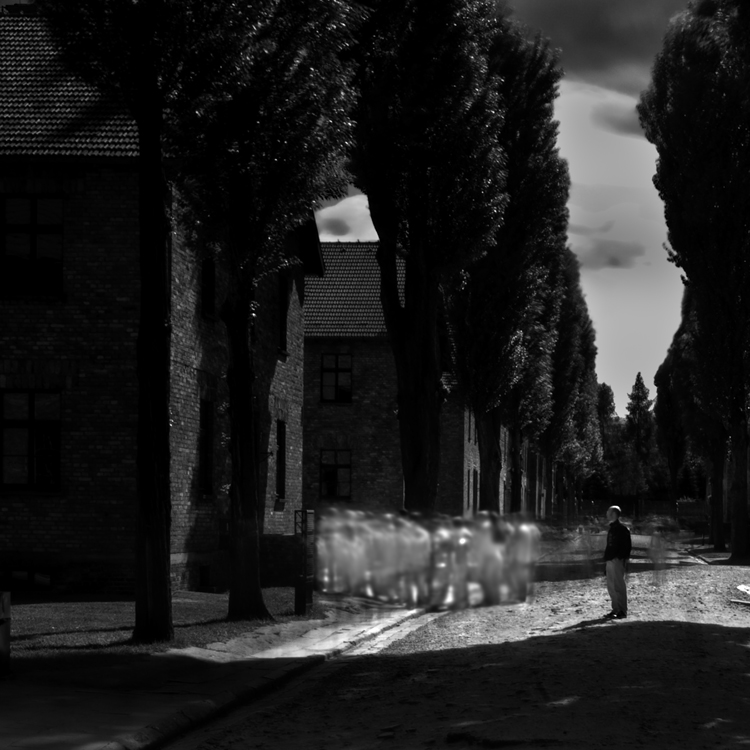
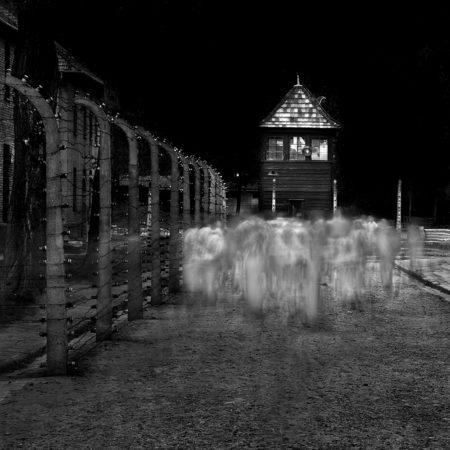
I would like to tell the story behind “The Ghosts of Auschwitz-Birkenau.”
My wife and I were visiting my son who was serving in the Peace Corps in Ukraine (providing balance to his two brothers who were serving in the Marines). Being part Polish, we decided to visit our homeland and took a train to Krakow. Upon arriving discussions began on what to see and of course Auschwitz-Birkenau was high on the list, but secretly I hoped we wouldn’t visit the camps because I did not want see a place of such sadness. However my wife wanted to go and so I agreed.
We took a bus tour that would spend about 1 hour at Auschwitz and 30 minutes at Birkenau. Even though I had my camera equipment with me, I had not planned on photographing the camps because it seemed that this might be disrespectful. The tour began indoors and we saw the meticulous records the German’s kept of their victims and then the piles of personal effects: glasses, shoes, hair and other items.
This was just too overwhelming and I felt like I was suffocating, so I signaled my family that I was going outdoors. Breathing in the open air I began to feel a bit better and slowly walked, looking down at my feet. The thought then came to me: how many had walked here before me, in these exact same footsteps and now were dead? How many had taken this same path and then had been murdered?
I began to wonder if the spirits of those who were dead still lingered, did they still inhabit this place? And then it suddenly struck me that I must photograph the spirits of those who had died here. I instinctively knew how I would do that, I would use long exposures of the other visitors at the camps, who would stand in proxy for the dead. The enormity of this task hit me as I realized that the bus was leaving in 45 minutes and so I ran from location to location, working incredibly fast.
Each location had its own challenges, I had to photograph people without their knowing it, because if they thought I was photographing they would politely move out of my way. I developed techniques to fool people into thinking I was not photographing, I would set up my equipment and then talk on the phone or look in my camera bag, and then trigger the camera with a remote shutter release.
I found that the closer I was to the scene, the harder it was to get the shot because people would see me and move out of my way, not knowing that I actually needed them in the picture! Auschwitz No. 9 was the most difficult image to get, it took many exposures to capture these ghosts.
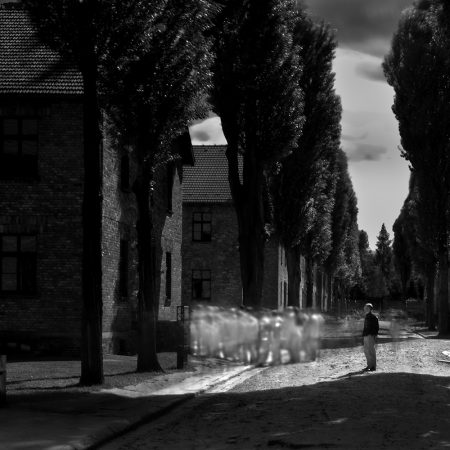
Another challenge was that people had to keep moving to produce the ghosting effects. So many shots were ruined when someone in the group would stop and interrupt the ghosting effect. In one image, Auschwitz No. 4, a man in the group stopped to read a historical placard. This is the only image that I’ve included a “mortal” because it seemed to say “I am completely unaware of the ghosts around me.”
It’s no simple matter to get the right ghosting effects; so many factors affect the image such as the color of the clothing people are wearing, the speed in which they walk, the angle they are walking in relation to the camera and of course the length of the exposure. I had to learn all of this in very short order and I was so grateful to be using digital so that I could get immediate feedback. There was so much to learn in such a short time, but I knew I had to finish before the bus left as I would not have another chance.
In one sense I felt prepared for this moment, for this opportunity. I had been working with long exposures for several years and I understood the basics, however I had never worked with people before and certainly not with unsuspecting subjects. I had to learn quickly and work quickly.
I do feel that I was inspired, both in concept and execution. As I looked at each scene I knew in my mind exactly how the finished image would look. However if you were to see the original shots and compare them to the final images, you would be surprised to see the extensive Photoshop work it took to bring the “shot” into compliance with my vision.
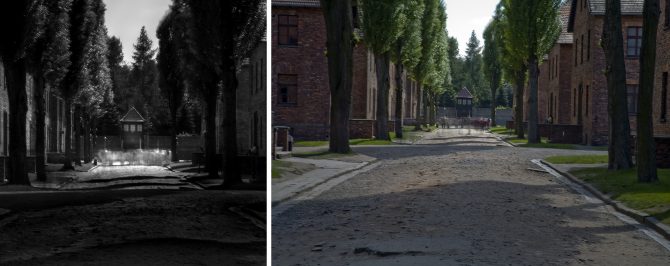
My processing included cropping the image to a square, darkening the scene for an almost nighttime look, increasing contrast, dodging up the ghosts and burning down distracting elements. You can see one “before and after” example above. Vision was the key to this series (remember my Rule of Thirds) and it was the constant that drove everything. You can view the entire Ghosts portfolio here.
Auschwitz-Birkenau is a depressing place, but I am glad that I went. I hope my images can portray the camps not just as a historical location, but as a place where real people lived and died.
Cole
P.S. I recently had the honor of meeting a group of Holocaust survivors who attended the opening of this exhibition in Dallas. I saw a very elderly woman in a wheel chair looking at my images and I introduced myself by saying: “Hi, my name is Cole Thompson and these are my images.” She responded by pointing at the wall and exclaiming: “These are my images!”
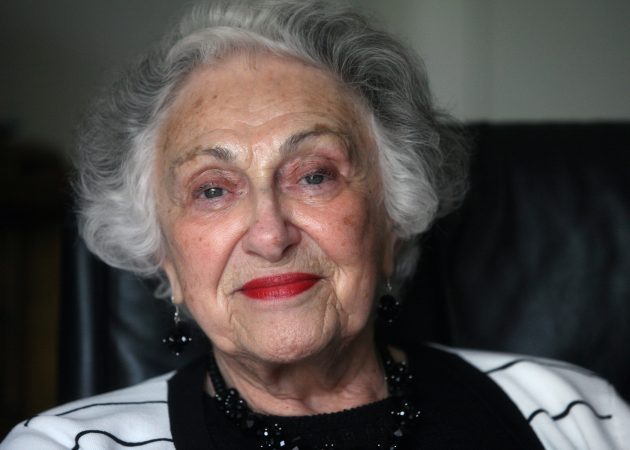
Her name was Edith Molnar and she had been interned at Auschwitz and recognized these locations. That was a humbling moment, to appreciate that you were talking to someone who had lived through these horrors, she was “living history.” Edith passed away several weeks later.
Cole
November 18, 2011
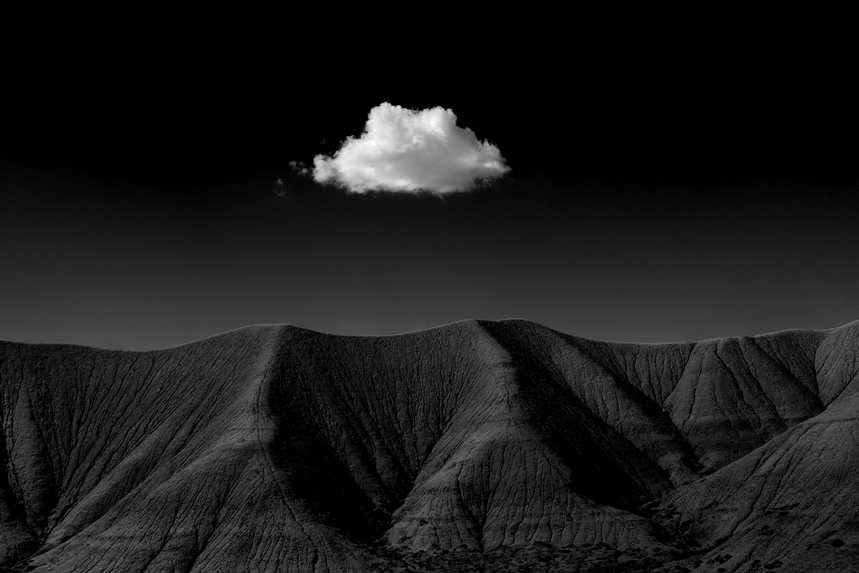
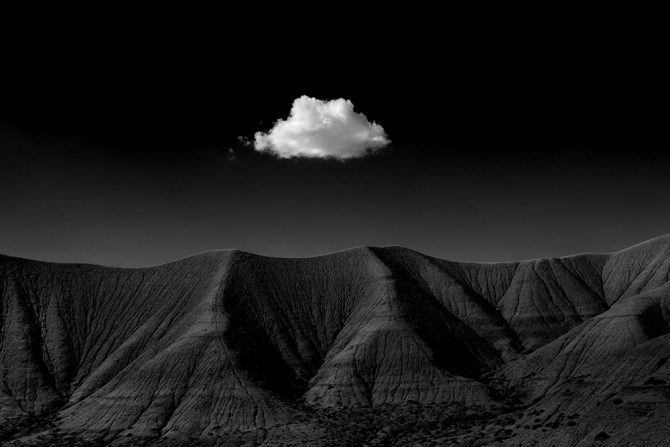
I’d like to tell you the story behind the image of Harbinger No. 1; how I came across it, how I created it and how it led to a ongoing portfolio.
My son Jem and I were traveling across Utah on a Father-and-Son road trip, it was summertime and it was 105 degrees in the Utah desert. Driving along I70 just across the border from Colorado we came upon these “mud hills” which caught my eye. They were so void of life that they made me think that this is what the moon must look like.
We stopped and I photographed for a while, but was unsatisfied. While the images were “interesting” they just didn’t feel complete and they certainly were not great. So we packed up and descended down the hill, eager to get back into the air conditioned truck.
But as were returning I saw this lone cloud moving very fast across the landscape. Based on its trajectory I knew that in just a minute it would be perfectly positioned over this dark symmetric hill that I had been photographing and would give my image the focal point that it needed. I ran up the hill as quickly as I could and hoped that I could get at least one shot, all the time thinking about the Ansel Adams story and how he rushed to get just one shot of Moonrise, Hernandez.
I quickly set up my tripod and camera, focused, adjusted my exposure and was lucky enough to get off two shots. I chose the above image of because it was centered above the hills and as many of you have noticed, I love centered and symmetric images. I was so fortunate to have this one perfectly shaped cloud come by and oblige me that day.
I like to name my images with the first word that comes to mind and this image immediately screamed “Harbinger” at me, and the dictionary’s definition became my artist statement:
Harbinger: \?här-b?n-j?r\ noun
1. one that goes ahead and makes known the approach of another; herald.
2. anything that foreshadows a future event; omen; sign.
People most often ask me about the processing of this image and I think that’s because many assume the key to a great image is in the processing. While there is no doubt that processing is important, it’s certainly no more important than the shot or your vision. If you focus on just the processing at the expense of vision or the shot, you may end up with a technically perfect but mediocre image. As an artist I try to focus on all three areas.
Vision
My vision for this image occurred at the moment I saw that cloud moving into position and I knew exactly how I wanted this image to look. It was going to be dark and that cloud was going to jump out at you! Sometimes that burst of vision can come later when I’m processing the image, but I don’t think it’s too important when the vision occurs as long as it does occur. Vision is what drives us to force the shot into compliance with our vision.
The Shot
When I composed this image I purposely centered the cloud and put the horizon in the center of the frame. Why? Because that’s just how the image felt to me. Next, I wanted a dark and graduated sky and so I used a polarizing filter which gave me both. On images i intend to be dark like this, I’ll often underexpose the image by 1 stop and then in processing I’ll dodge up the highlights.
Processing
When I converted this image to B&W I decreased the blue color channels to darken the sky, but I couldn’t go as far as I wanted because too much noise was being introduced. So to further darken the sky I burned it down with a very large and soft edged brush that was set at 1%. I work slowly to darken the sky to a pure black at the top and a very light gray at the hill’s edge. I dodged the cloud up so that it had a true white, but I was careful not to overdo it and lose highlight detail. This black sky and almost white cloud created this wonderful contrast that I love.
Next I burned the hills down so that visually they did not compete with the cloud for attention. And lastly I dodged up the very small edge of the ridge line to separate the hills from the sky. The final result is a dark image with a very bright subject, which is my preferred style.
When I created this first Harbinger image I really hoped that I could create an entire portfolio of similar images, but I never dreamed that I’d be lucky enough to find other such opportunities. I thought, how often will I see a single cloud over an interesting setting like this? But strangely enough I have found a few more and slowly my Harbinger portfolio is growing. Click here to see the entire portfolio.
Like all of my portfolios, this idea occurred spontaneously. I find that it’s easy to be creative when you are excited about a concept that inspires you!
Cole
February 10, 2011
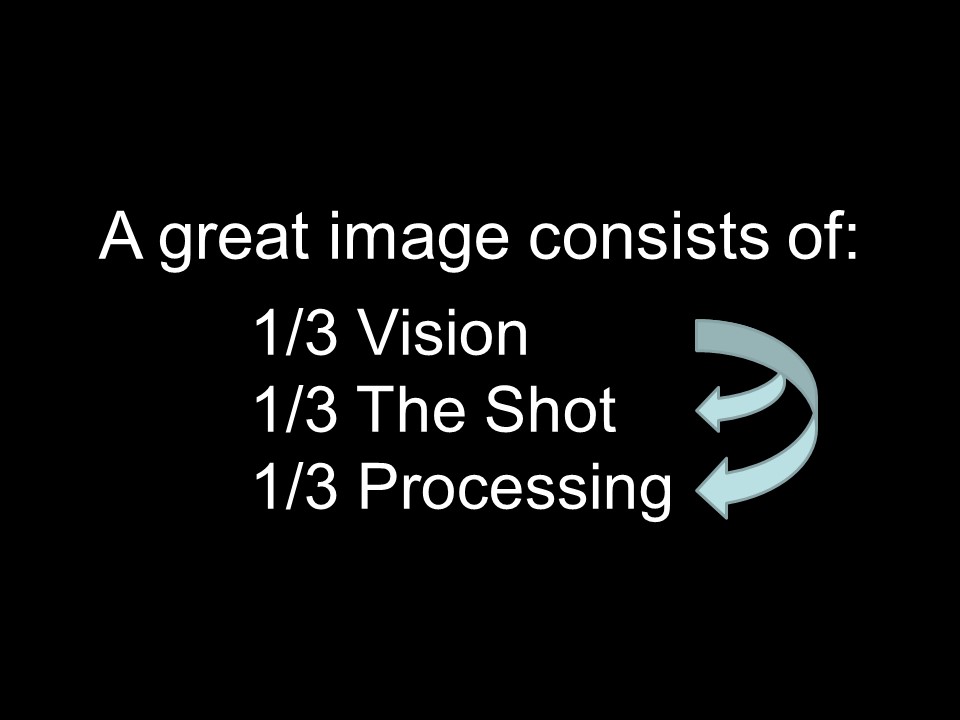
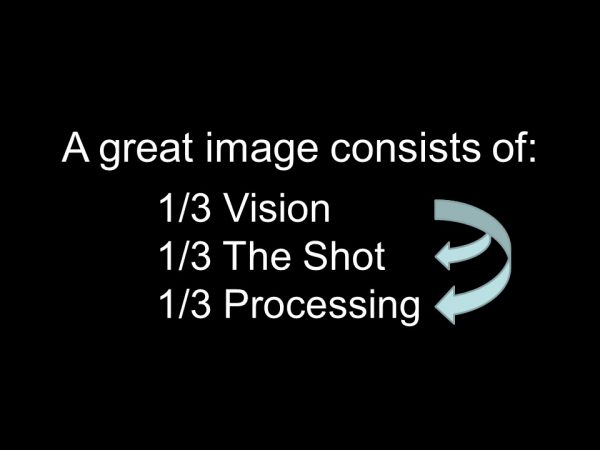

Many of you know of my disdain for photographic “rules” and so you might wonder why I’m writing about the “rule of thirds.” It’s because I’m writing about my rule of thirds:
A great image is comprised of 1/3 vision, 1/3 the shot and 1/3 processing
A great image begins and ends with your vision. Vision comes first and then it drives the shot and the processing.
Vision is a tough concept to describe, but I think each of us instinctively know how we want our image to look, and our job as an artist is to bring that image into compliance with our Vision.
When we pursue an image with Vision, then equipment and process becomes the servant and the creative process the master. It’s only then that great images can occur.
Vision is everything.
Cole
January 20, 2011

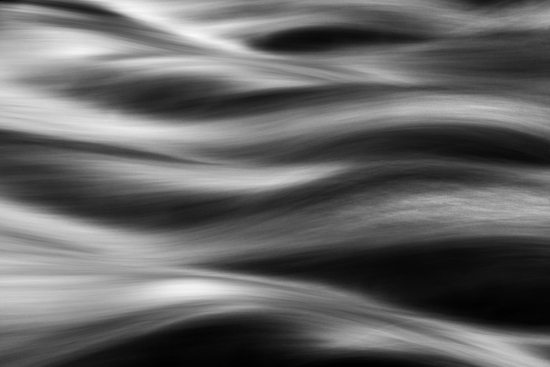
 I’ve just completed filming two DVD workshops, one on “Black and White Photography” in Death Valley and the other on “Long Exposures” filmed at La Jolla in San Diego. During the production a recurring theme kept coming up; that the foundation of a great image is a great composition and there are no substitutes. Using long exposures, HDR, shift-tilt, pinhole, Holga, soft focus, retro treatments, infra-red, or any technique and look are simply poor substitutes if the image is not built upon a solid composition.
I’ve just completed filming two DVD workshops, one on “Black and White Photography” in Death Valley and the other on “Long Exposures” filmed at La Jolla in San Diego. During the production a recurring theme kept coming up; that the foundation of a great image is a great composition and there are no substitutes. Using long exposures, HDR, shift-tilt, pinhole, Holga, soft focus, retro treatments, infra-red, or any technique and look are simply poor substitutes if the image is not built upon a solid composition.
I’ve fallen into this trap before, thinking that a particular “look” would make my work unique and therefore successful. Unique is certainly not a bad thing, but just because I’ve created a unique look doesn’t mean that I’ve created a great image!
My art is always best when I focus on the composition and then use a technique or look to enhance an already great image.
Cole
June 11, 2010


I often receive requests to show some “before and after” images to help people understand how much of my work is done in camera and how much is done in Photoshop. I’d say it’s generally about 50/50 but that can vary by image with some images almost ready right out of the camera and many requiring extensive processing in Photoshop.
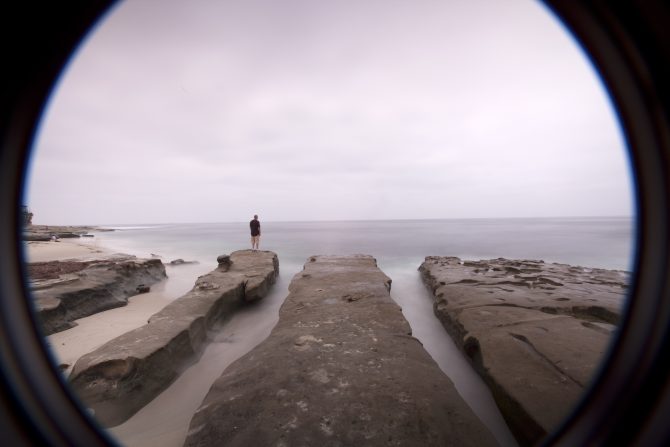
Lone Man No. 20 is a good example of a 50/50 image. As you can see, the image I started with and the final image are both quite similar and yet quite different. The original shot has all of the important elements; the composition, the long exposure of the water, the clouds and the lone man, but it doesn’t have the dramatic effect of the final image.
Probably the first change you’ll notice in the final image is that the severe vignetting has been repaired. I was shooting with an extremely wide angle lens and I had two stacked neutral density filters on my lens, as a result a great deal of the filter was included in the photograph. To repair this I first cropped the image and then I used the clone tool to fill in the missing corners.
Next you’ll notice that the sky in the original image has very low contrast and is quite bland. To bring out the sky detail I split the image into two halves, upper and lower, and converted them to b&w differently. In each conversion I used Photoshop’s “Channel Mixer” but in the upper half I used some blue channel to improve the contrast and detail in of the sky. Next I used some pretty aggressive dodging and burning to bring out the definition and detail in the clouds, this information was in the image but it was almost hidden to the eye. As a rule you can generally recover image detail as long as you have not over-exposed the image to the point that you have blown out the highlights.
Note: one of the side-effects of using blue channel in the conversion and dodging and burning is that the image can get very grainy. When using this technique you must carefully balance the good-effects with side-effects.
Next I converted the lower half of the image to b&w, darkened the image and greatly enhanced the contrast. This dark and contrasty approach is the look that I like and it often has the effect of making daytime look like night time. The March/April issue of Photo Technique Magazine featured an article on my work and they used the phrase “Darkness at Noon” to describe this look.
All of this produced a basic final image, but it still didn’t have the dramatic impact I was seeking and that I had pre-visualized before I captured the image. So my final step was to dodge and burn to bring out the highlights and selectively darken blacks to locally enhance contrast. As I did this I carefully monitored the histogram below:
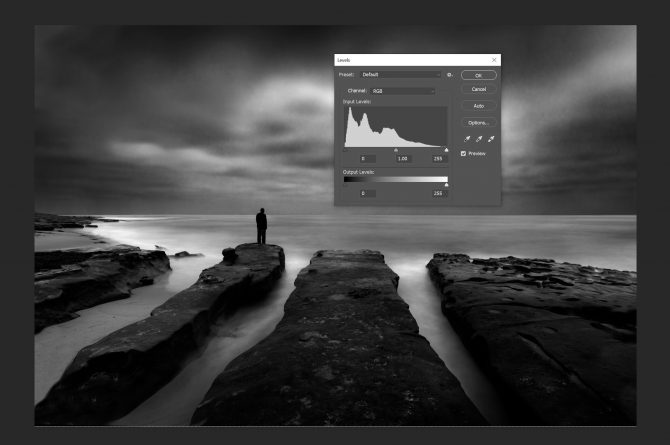
 This histogram shows that I have a good black and a good white, something your eye cannot always discern when looking at the image on the screen. Monitors are often out of adjustment and our eyes can be fooled, but the histogram never lies. People often complain to me that what looked good to them on screen, often prints flat and muddy. Generally the problem is revealed in their histogram; they lack a “true” black and good contrast.
This histogram shows that I have a good black and a good white, something your eye cannot always discern when looking at the image on the screen. Monitors are often out of adjustment and our eyes can be fooled, but the histogram never lies. People often complain to me that what looked good to them on screen, often prints flat and muddy. Generally the problem is revealed in their histogram; they lack a “true” black and good contrast.
As you can see from my final image, it does not represent reality. Reality is not my goal but instead I strive create images that reflect how I see the scene through my vision. That is why I advocate that photographers work just as hard on developing their vision, as they do on their technical skills and equipment. The image begins and ends in your mind’s eye.
April 7, 2010


Where do you find the “great” shots? It’s a question I’ve been thinking a lot about lately.
Earlier in my career I thought that you had to go to a great location to get a great shot. You know; Death Valley, the wilds of Africa or the mountains of New Zealand. These are beautiful locations and so it made sense to me that I would produce great images there.
Then I went through a period where I believed that great shots were everywhere and all that was needed was the vision to “see” them. I remember reading a statement by Edward Weston, who infirm and confined to a chair said that he ought to be able to look down at his feet and find a great image.
That’s a great theory, but what’s the reality? Does location contribute to the creative process? Can I really find great images in my own back yard?
My actual experience has been mixed; I have been to some great locations that have produced some great shots but there have been other times when I couldn’t see a thing, only to find another photographer had created incredible work at the same place. I would look at their images and marvel how it was that I didn’t see that. Conversely I’ve also been to some uninspiring locations and produced some wonderful images that others had passed by.
My current thought is that creating a great shot is like panning for gold. There are always a few nuggets laying on the surface, but for the most part the gold is hidden beneath the surface and you must really work hard to find it. So while beautiful locations have produced some great work for me (gold nuggets), the bulk of my images (gold dust) came about from hard work.
I have noticed that great locations can be inspirational, but without vision I’m only likely to see the shots that everyone else has photographed before. After all, when a gold nugget is large enough to be noticed, everyone else notices it too! Think about how many similar images of Yosemite you have seen, that’s because gold nuggets are easy to see.
A short time ago I was in a creative slump and went on three trips. At the start of each trip I really believed that the location would inspire me to create great images, but as each trip produced mediocre images I blamed it on the weather, the boring landscape or my lack of time. Eventually I had to face the reality that it wasn’t the location, it was me. My conclusion: I’d rather be inspired in a uninspiring location than to be uninspired in a inspiring place.
So how would I answer the question “Where do you find the ‘Great’ shots?” I think you find them wherever you’re at and while location can help, it can never take the place of vision.
Cole
February 22, 2010
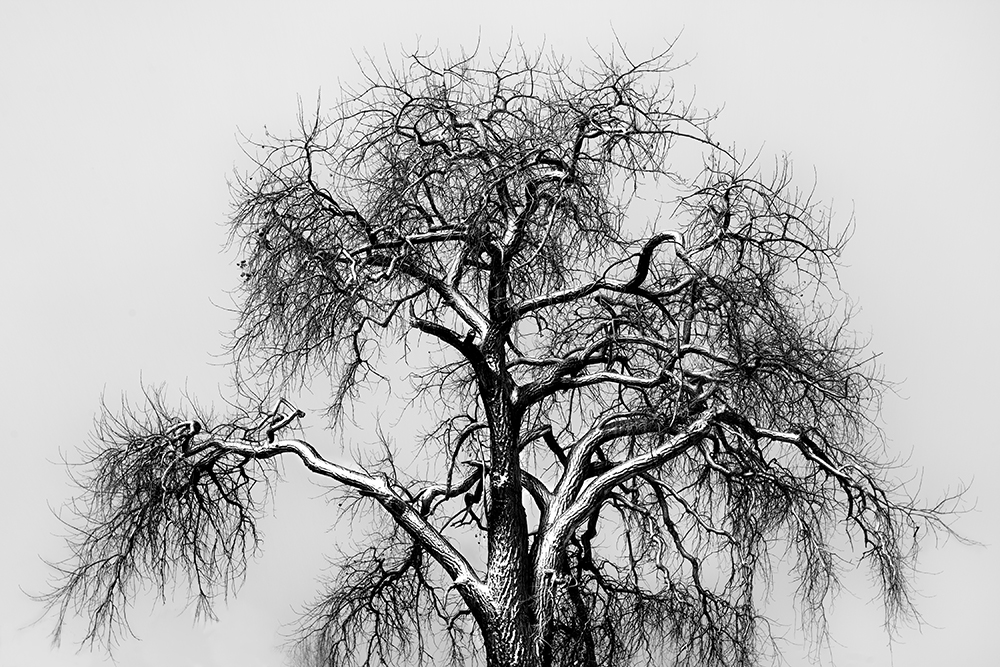

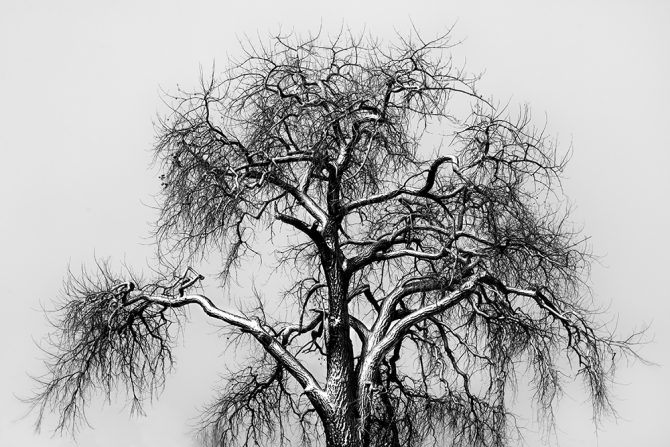
When people learn that my images are created digitally they often ask “do you manipulate your images?” To which I enthusiastically answer “Yes!”
Everything I do starting with how I frame the image, expose and process it, is intended to manipulate that image into alignment with my vision. Rarely, if ever, do I try to recreate what I saw with my eyes. I believe that my vision is the difference between me being a photographer who documents and an artist who creates. When I set up my camera at a scene, I already know what I want that image to look like and rarely does it resemble reality.
Some have suggested that “manipulation” is a “photographic sin” and I’ve heard others say that you shouldn’t do anything in Photoshop that you couldn’t do in the darkroom. I find it odd that we should freeze our progress and limit ourselves to the technology of the 1990’s under some sense of arbitrary purity, why not freeze our techniques to that of the 1890’s? My feeling is that art should be about the art, and not the process.
Many worship Ansel Adams as the master of photographic purity, and one that faithfully reproduced the scene with minimal manipulation. Recently I saw a series of photographs that were taken from the very same spot where Ansel had taken his most famous Yosemite images, but with a point and shoot camera. The images were striking because they so clearly revealed, in that side-by-side comparison, how much Adams manipulated his images. In my opinion that’s why Ansel was an artist, because he didn’t simply document a scene but created images that matched his unique vision. He was a master of “manipulation” and his work certainly did not represent reality.
Should photographers have any limits? I don’t think so; does a painter have limits, or an actor or musician? How would an art advance or a person grow if there was a list of things they could and couldn’t do?
But individually, each one of us will set personal limits, I certainly do. There are things that I just don’t do, not because I consider them wrong but because they do not fit within the vision and style of my work. For example I choose not to “add” to an image such as adding a person or object, but there are others whose work is completely based on adding such as Dominic Rouse. I love what Dominic does with his images and respect his work.
I don’t think there’s a right or wrong with art there shouldn’t be any do’s or don’ts. Ignore the world and it’s experts, find your own vision and go wherever that takes you.
Do I manipulate my images? You bet I do!
Cole
